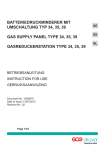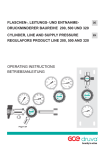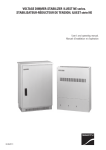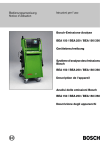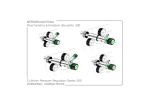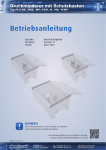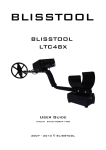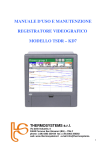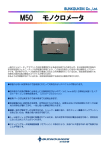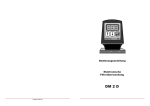Download Puregas PMD Operating instructions
Transcript
BETRIEBSANLEITUNG Stations- und Batteriedruckminderer Typ 16, 22, 24, 25, 27, 30 und 32 Gas Panels Type 16, 22, 24, 25, 27, 30 and 32 OPERATING INSTRUCTIONS Diese Armaturen sind Präzisionsinstrumente von höchster Qualität. Durch die Verwendung ausgewählter Materialien, durch hohe Oberflächengüte und Dichtheit lassen sich Druck und Durchfluß auch von reinsten Gasen ohne Beeinträchtigung der Reinheit präzise mit gleichbleibender Genauigkeit regeln. Alle Schritte - von der Konzeption, über die Fertigung bis zur Endkontrolle - unterliegen den strengen Kriterien unserer Qualitätssicherung nach DIN EN ISO 9001. 2. GRUNDLEGENDE SICHERHEITSHINWEISE 2.1 Hinweise in der Bedienungsanleitung Diese Bedienungsanleitung enthält die wichtigsten Hinweise, um das Druckgerät sicherheitsgerecht zu betreiben. Die Sicherheitshinweise sind von allen Personen zu beachten, die an den Armaturen arbeiten. Darüberhinaus sind die für den Einsatzort geltenden Regeln und Vorschriften zur Unfallverhütung zu beachten. 2.2 Verpflichtung des Betreibers Der Betreiber verpflichtet sich, nur Personen am Druckgerät arbeiten zu lassen, die mit den grundlegenden Vorschriften über Arbeitssicherheit und Unfallverhütung vertraut sind und andauernd Zugang zu diesen Vorschriften haben, das Sicherheitskapitel und die Warnhinweise in dieser Bedienungsanleitung gelesen und verstanden haben und geschult und an der Reduzierstation eingewiesen sind. Das sicherheitsbewußte Arbeiten des Personals wird in regelmäßigen Abständen überprüft. Die Zuständigkeiten des Personals für das Montieren, Inbetriebnahme und Bedienen sind klar festzulegen. Anzulernendes Personal darf nur unter Aufsicht einer erfahrenen Person am Druckgerät arbeiten. Alle Sicherheits- und Gefahrenhinweise sind stets in lesbarem Zustand zu halten. 2.3 Verpflichtung des Personals Alle Personen, die mit Arbeiten am Druckgerät beauftragt sind, verpflichten sich vor Arbeitsbeginn die grundlegenden Vorschriften über Arbeitssicherheit und Unfallverhütung zu beachten, sich mit dem Sicherheitsdatenblatt der verwendeten Gasart vertraut zu machen. Verwendung anderer Gasarten, der Überschreitung der zulässigen Eingangsdrücke, der Verwendung fremder bzw. nicht originaler Dichtungen. Mangelhafte Überwachung von Ausrüstungs-, Verschraubungs- und Dichtungsteilen, die einem Verschleiß unterliegen. Unsachgemäß durchgeführte Reparaturen. Überschreitung oder Unterschreitung des im Datenblatt angegebenen Temperaturbereichs während des Betriebs bzw. während der Lagerung. Katastrophenfälle durch Fremdkörpereinwirkung und höhere Gewalt. 2.4 Gefahren im Umgang mit dem Druckgerät Der Batterie-, bzw. Stationsdruckminderer (Druckgerät) ist nach dem Stand der Technik und den anerkannten sicherheitstechnischen Regeln gebaut. Dennoch können bei ihrer Verwendung Gefahren für Leib und Leben des Benutzers oder Dritter bzw. Beeinträchtigungen am Druckgerät oder an anderen Sachwerten entstehen. Das Druckgerät ist nur für die bestimmungsgemäße Verwendung zu benutzen . Störungen, die die Sicherheit beeinträchtigen können, sind umgehend zu beseitigen. 2.5 Bestimmungsgemäße Verwendung Das Druckgerät ist ausschließlich zur Entspannung von gasförmigen Medien aus Druckgasbehältern bestimmt. Eine andere oder darüber hinausgehende Benutzung gilt als nicht bestimmungsgemäß. Zur bestimmungsgemäßen Verwendung gehört auch das Beachten aller Hinweise aus der Bedienungsanleitung, die Einhaltung der Inspektions- und Wartungsarbeiten, das Beachten des Typenschildes und des Datenblattes. 2.7 Symbol- und Hinweiserklärung In der Bedienungsanleitung werden folgende Benennungen und Zeichen für Gefährdungen verwendet: Dieses Symbol bedeutet eine unmittelbar drohende Gefahr für das Leben und die Gesundheit von Personen. Das Nichtbeachten dieser Hinweise hat schwere gesundheitsschädliche Auswirkungen zur Folge, bis hin zu lebensgefährlichen Verletzungen. Dieses Symbol bedeutet eine möglicherweise drohende Gefahr für das Leben und die Gesundheit von Personen. Das Nichtbeachten dieser Hinweise kann schwere gesundheitsschädliche Auswirkungen zur Folge haben, bis hin zu lebensgefährlichen Verletzungen. 2.6 Gewährleistung und Haftung Grundsätzlich gelten unsere "Allgemeinen Verkaufs- und Lieferbedingungen". Diese stehen dem Betreiber spätestens seit Vertragsabschluß zur Verfügung. Gewährleistungs- und Haftungsansprüche bei Personen- und Sachschäden sind ausgeschlossen, wenn sie auf eine oder mehrere der folgenden Ursachen zurückzuführen sind: Nicht bestimmungsgemäße Verwendung des Druckgerätes. Unsachgemäßes Montieren, Inbetriebnahme, Bedienen und Warten des Druckgerätes. Betreiben des Druckgerätes bei defekten Sicherheitseinrichtungen oder nicht ordnungsgemäß angebrachten oder nicht funktionsfähigen Sicherheits- und Schutzvorrichtungen. Nichtbeachten der Hinweise in der Bedienungsanleitung bezüglich Transport, Lagerung, Montage, Inbetriebnahme, Betrieb, Wartung und Rüsten des Druckgerätes. Eigenmächtige bauliche Veränderungen an dem Druckgerät. Eigenmächtiges Verändern der Flaschenanschlüsse zur -1- + Dieses Symbol bedeutet eine möglicherweise gefährliche Situation. Das Nichtbeachten dieser Hinweise kann leichte Verletzungen zur Folge haben oder zu Sachbeschädigungen führen. Dieses Symbol gibt wichtige Hinweise für den sachgerechten Umgang mit dem Druckgerät und Sie erhalten Anwendungs-Tips und besonders nützliche Informationen. Das Nichtbeachten dieser Hinweise kann zu Störungen am Druckgerät oder in der Umgebung führen. Anwendungstips helfen Ihnen, alle Bedienungsanleitung SMD, BMD 1. ALLGEMEINES 1.1 Vorbemerkung Bedienungsanleitung SMD, BMD Funktionen an Ihrem Druckgerät optimal zu nutzen. 2.8 Organisatorische Maßnahmen Die erforderlichen persönlichen Schutzausrüstungen sind vom Betreiber bereitzustellen. Alle vorhandenen Sicherheits-Einrichtungen sind regelmäßig zu überprüfen. Bei Sauerstoffmangel oder zu hoher Schadstoffkonzentration sind von der Umgebungsatmosphäre unabhängige Atemschutzgeräte erforderlich (VBG 1). 2.9 Schutzeinrichtungen Vor jeder Inbetriebnahme des Druckgerätes müssen alle Sicherheitseinrichtungen sachgerecht angebracht und funktionsfähig sein. Schutzvorrichtungen und Sicherheitseinrichtungen dürfen nur nach Außerbetriebsetzen des Druckgerätes bzw. der Anlage und Absicherung gegen Wiederinbetriebnahme des Druckgerätes entfernt werden. Bei Lieferung von Teilkomponenten sind die Sicherheitseinrichtungen durch den Betreiber vorschriftsmäßig anzubringen. 2.10 Anlagen-Steuerung Auf keinen Fall Programmänderungen vornehmen! Nur eingewiesenem Personal ist es erlaubt, die Steuerung zu betätigen. 2.11 Sicherheits-Maßnahmen im Normalbetrieb Vor Einschalten des Druckgerätes sicherstellen, daß niemand durch das Inbetriebnehmen des Druckgerätes gefährdet werden kann. Mindestens einmal pro Jahr das Druckgerät auf Dichtheit und Funktionsfähigkeit der Sicherheitseinrichtungen überprüfen. 2.12 Gefahren durch elektrische Energie Arbeiten an elektrischen Bauteilen, Anzeige- und Steuerungseinheiten (z.B. Gasmangelanzeige) nur von einer Elektro-Fachkraft ausführen lassen. Die elektrische Ausrüstung der Anlage regelmäßig überprüfen. Lose Verbindungen und beschädigte Kabel sofort beseitigen. Der Schaltschrank bzw. die elektrischen Baugruppen sind stets verschlossen zu halten. Der Zugang ist nur autorisiertem Personal mit Schlüssel oder Werkzeug erlaubt. Sind Arbeiten an spannungsführenden Teilen notwendig, ist eine zweite Person hinzuzuziehen, die notfalls den Hauptschalter ausschaltet. 2.13 Gefahren durch Druckenergie Zu öffnende Systemabschnitte und Druckleitungen vor Beginn von Reparaturarbeiten drucklos machen. Flexible Schlauchleitungen in angemessenen Zeitabständen überprüfen und auswechseln, auch wenn keine sicherheitsrelevanten Mängel erkennbar sind. Durch äußere Einwirkungen wie hohe Temperaturen, Wärmestrahlung, Stoß und ähnliches können sich Druckgasflaschen oder unter Druck stehende Anlagenteile stark erwärmen bzw. bersten. Treffen Sie bitte entsprechende Vorsichts- und Sicherheitsmaßnahmen. 2.14 Besondere Gefahren durch Leckage nach außen Durch die Verwendung von sehr gefährlichen, gefährlichen oder weniger gefährlichen Gasen können bei Undichtigkeit des Druckgerätes Gefahren für Leib und Leben des Benutzers entstehen. Deshalb ist eine Betriebsanweisung gemäß § 20 GefStoffV, ein aktuelles EU-Sicherheitsdatenblatt nach § 14 GefStoffV und ein Unfallmerkblatt mit Hinweisen für den Arzt an geeigneter Stelle vorzuhalten. Die Bediener sind auf die besonderen Gefahren des Gases und auf eventuelle Personen- und andere Schutzmaßnahmen hinzuweisen. 2.15 Hinweise zu speziellen Gasarten Alle mit Sauerstoff in Berührung kommenden Teile müssen absolut öl- und fettfrei sein, Brand- und Explosionsgefahr! Nur Schmierstoffe mit Sauerstoffzulassung verwenden. Bei Acetylen keine Rohrleitungen oder andere Anlagenteile aus Kupfer verwenden! Besondere Gefährdungspotentiale des Acetylens beachten! 2.16 Austreten schädlicher Gase und Dämpfe Bei geöffneten Sicherheitseinrichtungen oder Störfällen können schädliche Gase und Dämpfe entweichen (s. o.). Für ausreichend Entlüftung oder Absaugung sorgen. -2- Bei gefährlichen Medien besondere Schutzvorkehrungen treffen. Insbesondere Abblaseventil und Spülventile über feste Rohrleitungen ableiten und die Stoffe sicherheitsgerecht und umweltverträglich entsorgen. 2.17 Wartung und Instandhaltung, Störungsbeseitigung Vorgeschriebene Einstell-, Wartungs- und Inspektionsarbeiten fristgemäß durch den Hersteller oder durch vom Hersteller autorisierten Fachbetrieben durchführen lassen. Bedienungspersonal und Nutzer vor Beginn der Wartungs- und Instandhaltungsarbeiten informieren. Alle zur Ansteuerung der Druckgeräte bzw. der Anlage vor- und nachgeschalteten Betriebsmedien wie Druckluft und Hydraulik gegen unbeabsichtigte Inbetriebnahme absichern. Bei allen Wartungs-, Inspektions- und Reparaturarbeiten die zugehörigen Betriebsmittel spannungsfrei schalten und Hauptschalter gegen unerwartetes Wiedereinschalten sichern. Hauptschalter abschließen und Schlüssel abziehen. Ein Warnschild gegen Wiedereinschalten anbringen. Gelöste Schraubverbindungen auf festen Sitz kontrollieren. Nach Beendigung der Wartungsarbeiten Sicherheitseinrichtungen auf Funktion überprüfen. 2.18 Bauliche Veränderungen an dem Druckgerät oder der Anlage Ohne schriftliche Genehmigung des Herstellers keine Veränderungen, An- oder Umbauten am Druckgerät oder der Anlage vornehmen. Anlagenteile in nicht einwandfreiem Zustand sofort austauschen. Nur Original-Ersatz- und Verschleißteile verwenden. 2.19 Reinigen der Gasgeräte und Entsorgung der Rückstände Verwendete, zur Reparatur anstehende Gasgeräte mit einem inerten Gas (Stickstoff, Argon) spülen. Feste Gasrückstände sachgerecht handhaben und entsorgen. Insbesondere nicht durch ölige Lappen oder mit Schmierstoffen verunreinigen. Nicht mit Lösungsmitteln Gesetze und Verordnungen GSG Gerätesicherheitsgesetz mit aVV allgem. Verwaltungsvorschrift zum GSG, 6. GSGV Druckbehälterverordnung, 7. GSGV Gasverbrauchseinrichtungsverordnung und GasHL-VO Gashochdruckleitungsverordnung. ChemG Chemikaliengesetz mit GefStoffV Gefahrstoffverordnung und ArbstoffV Arbeitsstoffverordnung. AcetV Acetylenverordnung. BImSchG Immissionsschutzgesetz mit BImSchV FCKW-Halon-Verbots-Verordnung und 2. BImSchV Emissionsbegrenzung von leichtflüchtigen Halogenkohlenwasserstoffen. Techn. Regeln, Unfallverhütungsvorschriften. TRAC Techn. Regeln für Acetylenanlagen und Calciumcarbidlager TRAC 204, 206, 207, 208. Technische Regeln TRB 610, 700, 801 / 26, 801 / 27. TRR Techn. Regeln Rohrleitungen TRR 100. TRG Techn. Regeln Druckgase TRG 100, 101, 102, 103, 104, 250, 253, 254, 256, 280, 310, 311, 360, 370. TRGL Technische Regeln für Gashochdruckleitungen TRGL 101, 111, 141, 151, 161, 171, 181, 191, 195, 201, 211, 231, 241, 242, 251, 261, 291, 295, 501, 511, 521. UVV Unfallverhütungsvorschriften VBG 1, 4, 15, 50, 61, 62. ZH 1 Schriften, Merkblätter, Sicherheitsregeln ZH1/8 u.f., ZH1/10, ZH1/15, ZH1/16, ZH1/20, ZH1/20.1, CEN-Normen (European Committee for Standardization) EN 585, 562. 4.4 Kennzeichnung Die Typenschilder weisen folgende Kennzeichnungen aus: DIN-Normen (Deutsches Institut für Normung e.V.) DIN 8545, 3380, 2462, 2403, 12920, 12925, 16006. VDE-Richtlinien (Verband Deutscher Elektrotechniker) VDE 0100, 0170, 0190. Datenblätter Baureihe 100, 200, 230, 330 und 500. 3. LAGERUNG, TRANSPORT Alle Teile müssen sauber verpackt, staubfrei, trocken und gut verschlossen gelagert werden. Nur sachgerechte Verpackung benützen. Keine lösungsmittelhaltigen Reinigungsmittel anwenden! Vor Rücksendung an den Hersteller unbedingt alle Komponenten, die mit korrosiven oder toxischen Gasen in Kontakt waren, mit Inertgas spülen. 4. TECHNISCHE DATEN 4.1 Druckminderer Maximal sechs Ein- und Ausgangsbohrungen mit NPT 1/4”Innengewinde ermöglichen vielfältige Anschluß- und Variationsmöglichkeiten des Druckminderers. 4.2 Absperrventil MVA Durch 90°-Drehung einfach zu bedienendes Absperrventil mit Einrasteffekt (Klick). Die Auf-/Zu-Stellung ist eindeutig erkennbar: Handrad parallel zur Gasleitung - Ventil geöffnet. Handrad quer zur Gasleitung - Ventil geschlossen. 4.3 Zubehör Für die Baureihen ist umfangreiches Zubehör wie Verschraubungen, Schlauchtüllen, Kontaktmanometer und -3- Typ: Wst: SMD 500-14 Ms/PVDF/EPDM pein : 200 bar paus : 1 - 12 bar Achtung! Druckbelastete Teile. Service nur durch autorisierte Personen He Hersteller, Herstellungszeitpunkt, Typbezeichnung, Zugelassener Vordruck (p ein), gerätespezifischer Hinterdruckbereich (paus ), Werkstoffe von Druckminderergehäuse und Sitzdichtung, Sicherheitshinweis und Kurzzeichen für die Gasart. Die Seriennummer wird als gerätespezifische Kennzeichnung auf einem separaten Schild im Barcode 128 und in Klarschrift angegeben. 4.5 Fließschemata Abbildung 1 zeigt die Fließschemata von Stations- und Batteriedruckminderern des Standardlieferprogramms. 5. AUFSTELLUNG, MONTAGE, ERSTE INBETRIEBNAHME 5.1 Befestigung der Armaturen + Die Entspannungsstation ist stabil an der Wand zu befestigen. Die Montagehöhe der unteren Befestigungsleiste (Bohrung Konsole) beträgt 164 cm. Zur sicheren Handhabung sind für die Arretierung der Gasflaschen Halterungen (lieferbares Zubehör) anzubringen. 5.2 Vorbereitungen Kontrollieren Sie zuerst an Hand des Typenschildes und der Beschriftung, ob der Druckminderer für den vorgesehenen Verwendungszweck geeignet ist (Gasart, Druck, Werkstoff). Bedienungsanleitung SMD, BMD 2.21 Gesetze, Verordnungen, Normen, Vorschriften. ISO Normen (Internat. Organisation for Standardization) ISO 2503. Flammensperren lieferbar. Bitte wenden Sie sich diesbezüglich an den Hersteller. Montage- und Einbauvorschriften für diese Komponenten sind unbedingt zu befolgen. 95.10. In einigen Fällen kann das ungünstige Zusammenwirken bestimmter Einflußgrößen wie z. B. Durchfluß und Druckbereich aber auch die Gasart selbst zu Geräuschentwicklungen führen. Bitte setzen Sie sich in solchen Fällen mit dem Hersteller in Verbindung. ZH1/108 u.f., ZH1/119, ZH1/180, ZH1/244, ZH1/288, ZH1/ 298, ZH1/307, ZH1/309, ZH1/383, ZH1/384, ZH1/399, ZH1/400, ZH1/409, ZH1/479, ZH1/605. Hersteller reinigen. 2.20 Geräuschentwicklung Bedienungsanleitung SMD, BMD Überprüfen Sie, ob der Werkstoff der weiterführenden Versorgungsleitung für die entsprechende Gasart geeignet ist. Schließen Sie dann die Versorgungsleitung an den Brauchgasausgang des Stations- bzw. Batteriedruckminderers an. Als Anschlußverschraubung empfehlen wir Klemmringverschraubungen, die - falls mitbestellt - bereits in den Ausgang der Armatur eingedichtet sind. Die Montage erfolgt durch Einführen des Rohres in die Öffnung der Überwurfmutter der Verschraubung bis zum Anschlag. Die Überwurfmutter wird zunächst mit der Hand dann mit einem Gabelschlüssel (1 ¼ Umdrehungen) fest angezogen. Abblaseventil und Spülausgang werden, soweit vorhanden, in gleicher Weise an eine Abgasleitung angeschlossen. Bitte die Abgasleitung an eine geeignete und gefahrlose Stelle führen und ausreichende Länge vorsehen (Personengefährdung!). 5.2.1 Montage der Anschlußwendel an die Station Die Edelstahl-Wendelleitung zur Verbindung der Station mit der Gasflasche wird immer separat mitgeliefert. Zunächst die richtige Zuordnung der Wendelleitung zur Armatur überprüfen. Auf der Anschlußmutter der Wendelleitung ist die Nummer eingeschlagen, welche der Gasartzuordnung gemäß DIN 477 entspricht. Es gibt nur eine Ausführung von Anschlußwendeln. Diese ist für den Anschluß an Stations- als auch Batteriedruckminderer (linke und rechte Seite) gleichermaßen geeignet. Zur Montage der Anschlußwendel an die Station zunächst die Kunststoffschutzkappe vom Anschlußgewinde der Station und aus der Wendel-Anschlußmutter entfernen. Bitte darauf achten, daß die mitgelieferte Flachdichtung in die Überwurfmutter eingelegt ist. Die Überwurfmutter dann auf das Anschlußgewinde am Eingang der Station zunächst von Hand aufschrauben und anschließend mit einem Gabelschlüssel (SW 17) festziehen. 5.2.2 Anschließen der Anschlußwendel an die Gasflasche Gewinde von Flaschenventil und Überwurfmutter an Wendel müssen in einwandfreiem Zustand sein. Immer nur neue Dichtungen verwenden. Dichtungen dürfen nicht deformiert sein und keine Spuren von Schmutz oder Metallspänen aufweisen. Nur Original-Flaschenanschlußwendeln des Herstellers entsprechend der eingesetzten Gasart verwenden. Dichtungen auf richtigen Sitz im Anschlußstutzen der Wendel überprüfen. Auf Links- oder Rechtsgewinde der Flaschenanschlußmutter achten. Linksgewinde sind dadurch gekennzeichnet, daß auf der Außenseite der Mutter eine umlaufende Nut eingefräst ist. Die Mutter zunächst von Hand auf das Flaschenventilgewinde aufschrauben, dann mit einem Gabelschlüssel fest anziehen. Dabei am Haltegriff der Wendelleitung unbedingt gegenhalten. Keine Schlüsselverlängerungen benützen, da sonst Gewinde und Dichtung zerstört werden können. Dies kann zu Leckage und unkontrolliertem Gasaustritt führen! 5.3 Eigengasspülung + Stations- oder Batteriedruckminderer mit Eigengasspülung werden eingesetzt, damit die beim Flaschenwechsel ins System eingedrungene Atmosphärenluft entfernt werden kann. 1. Spülgasausgangsventil (9) und Brauchgasausgangsventil (6) - soweit vorhanden - schließen (Ventilgriff steht quer zur Rohrleitung). 2. Handbetätigtes Brauchgaseingangsventil (11) schließen. Bei Geräten ohne oder mit automatisierten Eingangsventilen muß der Druckminderer (3) durch Drehen des Handrades gegen den Uhrzeigersinn entlastet (geschlossen) werden. 3. Flaschenventil (1) langsam öffnen. 4. Brauchgas in die Wendelleitung (2) strömen lassen und dort einige Sekunden verweilen lassen. Flaschenventil (1) wieder schließen. 5. Spülausgangsventil (9) kurz öffnen und die jetzt in der Wendelleitung enthaltene Gasmenge entweichen lassen. Spülausgangsventil (9) dann sofort wieder schließen. 6. Die Schritte 3. bis 5. fünf- bis siebenmal wiederholen. 5.4 Fremdgasspülung + Stationen mit Fremdgasspülung ermöglichen: -4- + die Trocknung der Armatur bzw. das Entfernen feuchter Atmosphärenluft, die vor der Inbetriebnahme oder beim Flaschenwechsel in die Station eingedrungen sein kann, das Freispülen der Armatur von giftigen, korrosiven oder selbstentzündlichen Gasen vor dem Flaschenwechsel und vor Außerbetriebnahme. Trockenes, sauberes Spülgas N 2 5.0 oder Ar 5.0 ist Voraussetzung für ein erfolgreiches Spülen. 1. Überprüfen, ob Spülgaseingang (12), Spülgasausgang (10), Brauchgasausgang (7) und Anschlußwendel (2) ordnungsgemäß angeschlossen sind. 2. Brauchgasausgangsventil (6), Brauchgaseingangsventil (11) sowie Spülgaseingangsventil (14) und Spülgasausgangsventil (9) schließen (Handrad der Ventile steht quer zur Rohrleitung). 3. Druckminderer (3) durch Drehen des Handrades gegen den Uhrzeigersinn schließen (entlasten). 4. Spülgaseingangsventil (14) öffnen. 5. Brauchgaseingangsventil (11) l a n g s a m öffnen. 6. Druckminderer (3) durch Drehen des Handrades um ca. zwei Umdrehungen im Uhrzeigersinn teilweise öffnen. 7. Das Spülgaseingangsventil (14) schließen. Das jetzt in die Station eingeströmte Spülgas einige Sekunden verweilen lassen. 8. Das Spülgasausgangsventil (9) kurz öffnen und Spülgas über den Spülgasausgang (10) entweichen lassen. Das Spülgasausgangsventil (9) sofort wieder schließen. 9. Die Schritte 4., 7. und 8. fünf- bis siebenmal wiederholen. 10. Alle Ventile der Station schließen. Druckminderer (3) durch Drehen des Handrades gegen den Uhrzeigersinn vollständig schließen. 5.5 Inbetriebnahme Bei Verwendung von giftigen, korrosiven oder selbstentzündlichen Gasen ausschließlich Stationen mit Fremdgasspülung vorsehen. Vor Inbetriebnahme muß an Hand des Typenschildes überprüft werden, ob die vorliegende Armatur für den vorgesehenen Verwen- 6. FLASCHENWECHSEL UND AUSSERBETRIEBNAHME 6.1 Flaschenwechsel + Beim Wechseln der Flaschen mit giftigen, korrosiven Gasen sind entsprechende Personenschutzmaßnahmen zu treffen (Atemschutz, Augenschutz und Schutzkleidung). MAK-Werte (siehe Technische Regeln für Gefahrenstoffe, TRGS 900) beachten, richtige Atemschutzfilter bereit halten. Wurden aus der Druckgasflasche giftige oder korrosive Gase entnommen, ist vor dem Auswechseln der leeren Flasche die Anlage mit inertem Gas zu spülen (s. Kap. 5.4 ”Fremdgasspülung). Damit wird erreicht, daß sich das in der Leitung befindliche Restgas durch die Abgasleitung sicher entsorgt wird. 1. Flaschenventil (1) an der Gasflasche schließen. 2. Brauchgasausgangsventil (6) und/oder -eingangsventil (11) - soweit vorhanden - schließen. 3. Bei giftigen, korrosiven oder selbstentzündlichen Gasen die Fremdgasspülung durchführen (s. Kap. 5.4). 4. Anschlußwendel (2) vom Flaschenventil (1) lösen. 5. Bei Verwendung eines Trockenfilters den Filterkorb bei jedem Flaschenwechsel austauschen (siehe separate Anleitung). 6. Neue Brauchgasflasche anschließen. (s. Kap. 5.2.2). 7. Vor Wiederinbetriebnahme der Armatur ggf. Eigengasspülung (s. Kap. 5.3) bzw. Fremdgasspülung (s. Kap. 5.4) mit nachfolgender Eigengasspülung (s. Kap. 5.3) durchführen. 6.2 Außerbetriebnahme Bei kurzzeitiger Unterbrechung der Gasentnahme genügt das Schließen des Brauchgasausgangsventils (6). Das Schließen des Druckminderers (3) alleine garantiert keine Dichtheit, es kann ein Gasaustritt durch die Schläuche oder die angeschlossenen Verbraucher stattfinden. Bei längerer Unterbrechung muß der Druckminderer (3) durch Drehung des Handrades gegen den Uhrzeigersinn entspannt werden. Aus Sicherheitsgründen immer das Flaschenventil schließen. Bei Ausbau der kompletten Ein- oder Zweiflaschenanlage generell beachten: + Druckregler und Leitungen durch Ableiten des Gases über den Verbraucher entspannen, Zeiger von Vor- und Hinterdruckmanometer müssen vollständig auf ”O” stehen. Entsprechende Personenschutzmaßnahmen sind zu treffen (Atemschutz, Augenschutz und Schutzkleidung). MAK-Werte (siehe Technische Regeln für Gefahrenstoffe, TRGS 900) beachten, richtige Atemschutzfilter bereit halten. Bei korrosiven bzw. giftigen Gasen alle Komponenten mit Inertgas spülen (siehe Kap. 5.4 "Fremdgasspülung"). -5- 7. WARTUNG UND BETRIEBS- STÖRUNGEN 7.1 Wartung Reparaturen und Wartungen sind aus Sicherheitsgründen nur vom Hersteller oder durch vom Hersteller autorisierte Fachbetriebe ausschließlich mit Originalersatzteilen durchzuführen. Bei Stationen mit Trockenfilter beachten Sie bitte die spezielle Bedienungsanleitung. Flexible Schlauchleitungen sind einmal jährlich durch einen Drucktest auf Dichtheit zu prüfen und gegebenenfalls auszuwechseln. Um eine einwandfreie Funktion und gleichbleibende Betriebssicherheit der Armaturen sicherzustellen, sollen alle Komponenten einer Gasversorgung jährlich einmal vom Hersteller überprüft werden. Hierfür empfiehlt sich der Abschluß eines Wartungsvertrages. Bitte beachten Sie die Garantie- und Lieferbedingungen des Herstellers sowie die Grundlegenden Sicherheitshinweise im zweiten Kapitel. 7.2 Betriebsstörungen Diese Druckminderer arbeiten stets sehr zuverlässig. Sollte dennoch der Hinterdruck unzulässig ansteigen und/oder das Abblaseventil ansprechen, so setzen Sie sich bitte mit dem Hersteller in Verbindung. 8. HERSTELLUNG Technische Änderungen, die dem Fortschritt dienen, sind vorbehalten. Printed in Germany. Ausgabe BA BSMD Typ -16-22-24-25-27-30-32 d&e.pmd. V1/230305. © Hersteller siehe Aufdruck Rückseite. Bedienungsanleitung SMD, BMD dungszweck geeignet ist (Gasart, Druck, Werkstoff, etc.) Vor Einschalten des Druckgerätes sicherstellen, daß niemand durch das Inbetriebnehmen des Druckgerätes gefährdet werden kann. Vor Inbetriebnahme und Befüllen des nachfolgenden Leitungssystems gegebenenfalls Eigengasspülung (s. Kap. 5.3) bzw. Fremdgasspülung (s. Kap. 5.4) mit nachfolgender Eigengasspülung (s. Kap. 5.3) durchführen und alle Verschlußstopfen entfernen. Aus Sicherheitsgründen empfehlen wir in jedem Fall die Montage einer Abgasleitung. 1. Überprüfen, ob Spül-, Abgasleitungen und die Wendel ordnungsgemäß angeschlossen sind. 2. Alle Ventile der Armatur schließen (Griff quer zur Rohrleitung). 3. Handrad des Druckminderers (3) bis zum Anschlag gegen den Uhrzeigersinn drehen - Durchgang ist damit geschlossen. 4. Flaschenventil (1) langsam öffnen. 5. Brauchgaseingangsventil (11) (soweit vorhanden) langsam !! öffnen. 6. Gewünschten Hinterdruck durch Drehen des Handrades im Uhrzeigersinn am Druckminderer (3) einstellen. 7. Brauchgasausgangsventil (6), soweit vorhanden, (insbesondere bei großen nachgeschalteten Rohrvolumen) l a n g s a m !! öffnen. Abb.1: Fließschemata BMD und SMD SMD ##2-16 SMD ##0-16 SMD ##0-16 7 SMD ##0-22 7 SMD ##2-22 SMD ##0-24 7 10 7 10 7 5 6 3 5 4 2 1 8 5 6 7 8 1 cylinder valve 2 spiral tube 3 press.reg. single stage: Typ ##0-xx press.reg. double stage: Typ ##2-xx 4 inlet pressure gauge 10 outlet pressure gauge process gas outlet valve process gas outlet safety valve 9 10 11 12 13 Spülgasausgangsventil Spülgasausgang Brauchgaseingangsabsperrventil Spülgaseingang Rückschlagventil 9 10 11 12 13 purge gas outlet valve purge gas outlet process gas inlet shut-off valve purge gas inlet non return valve 7 5 3 13 6 5 4 8 7 8 4 11 5 4 9 9 3 14 11 11 11 2 2 1 1 2 1 1 2 8 SMD ##2-27 BMD ##0-30 fig. 1: flow scheme BMD and SMD -6- 2 1 1 8 SMD ##0-27 2 1 11 3 11 3 3 9 11 2 9 8 13 14 4 2 10 12 10 5 6 11 1 12 7 9 9 8 Hinterdruckmanometer Brauchgasausgangsabsperrventil Brauchgasausgang Sicherheitseinrichtung: Abblaseventil 5 6 7 8 4 3 2 8 1 Flaschenventil 2 Anschlußwendel 3 Druckminderer einstufig: Typ ##0-xx Druckminderer zweistufig: Typ ##2-xx 4 Vordruckmanometer 5 4 5 3 1 1 8 9 9 3 2 8 7 6 3 2 1 4 4 5 6 5 4 6 6 SMD ##0-25 7 SMD ##0-24 10 10 BMD ##0-32 1. General 2. Fundamental safety instructions 3. Storage and transport 4. Technical data 5. Installation, assembly, commissioning 6. Changing cylinders and ending operation 7. Servicing and malfunctions 8. This document 1.2 PREFACE These pure gas components are precision instruments of superior quality. The individual components are coordinated with each other and allow the flexible configuration of high-quality pure gas supply systems. The use of selected materials, high-quality surface finishing and excellent leak tightness ensure that the pressure and flow of even the purest gases can be controlled with constant precision without contamination of purity. All of the steps involved - from design to manufacture to final quality inspection - must meet the strict criteria of our quality assurance program. 2. FUNDAMENTAL SAFETY INSTRUCTIONS 2.1 Information in the operating instructions The essential information which is required for safe operation of the pressure device is contained in these operating instructions. The safety instructions must be observed by all persons who work on the fittings. Additionally, the rules and regulations which apply at the operating location must be observed. 2.2 Obligation on operating authority The operating authority undertakes to allow only such persons to work on the pressure device who are familiar with the fundamental regulations concerning occupational safety and accident prevention, and who always have access to these regulations, have read and understood the chapter on safety and the warnings in these operating instructions and have been trained, and introduced to the reduc-ing station. Safety-conscious working of personnel is to be checked at regular intervals. Responsibility of personnel for assembly, start-up and operation must be clearly defined. Trainees must only work on the pressure device under supervision by an experienced person. All information on safety and danger must always be kept in a legible condition. 2.3 Obligation on personnel Before starting work, all persons who are instructed to work on the pressure device undertake to observe the fundamental regulations concerning occupational safety and accident prevention, familiarize themselves with the safety data sheet for the type of gas being used. 2.4 Dangers associated with handling of the pressure device The battery or station pressure regulator (pressure device) is constructed according to state-of-the-art and recognized safety rules. Despite this, use of the device can cause danger to life and limb of the user or third parties, or damage to the pressure device or other property. The pressure device must only be used for the intended use. Malfunctions which could impair safety must be rectified immediately. 2.5 Intended use The pressure device is only to be used for expanding gaseous media from gas cylinders. Any use other than or exceeding this is regarded as improper use. The intended use also encompasses observing all information in the operating instructions, carrying out inspection and maintenance work, observing the rating plate and the data sheet. 2.6 Guarantee and liability Our “General Conditions of Sale and Delivery” apply. These are available to the operating authority at the latest on formation of the contract. Guarantee and liability claims -7- regarding personal injury and damage to property are excluded if they result from one or more of the following causes: Improper use of the pressure device. Incorrect assembly, start-up, operation or servicing of the pressure device. Operation of the pressure device with defective safety equipment, or with incorrectly installed or non-functioning safety and protection devices. Non-observance of information in the operating instructions relating to transport, storage, assembly, start-up, operation, servicing and equipping of the pressure device. Unauthorized constructional alterations to the pressure device. Unauthorized alteration of the cylinder connections for use of other gas types, exceeding of permissible inlet pressures, use of extraneous or non-original seals. Insufficient monitoring of equipment, screwed fittings, and sealing parts, which are subject to wear. Repairs carried out incorrectly. Temperature exceeds or falls below the temperature range indicated in the data sheet, during operation or storage. Unforseen calamities resulting from effect of foreign body or force majeure. 2.7 Explanation of symbols and information The following designations and symbols are used in the operating instructions to indicate dangers: This symbol indicates an immediate threat of danger to the life and health of persons. Ignoring this information will have serious consequences which are damaging to health. This may include lifethreatening injury. This symbol indicates a possible threat of danger to the life and health of persons. Ignoring this information can have serious consequences which are damaging to health. This may include life-threatening injury. Operating instructions SMD, BMD 1. GENERAL 1.1 Contents Operating instructions SMD, BMD This symbol indicates a situation which might be dangerous. Ignoring this information can result in minor injury or damage to property. + This symbol indicates important information for correct handling of the pressure device. Hints for operation and particularly useful information are provided. Ignoring this information can result in malfunctions at the pressure device or in the surrounding area. Hints for operation help you to use all the functions of your pressure device optimally. 2.8 Organizational measures The required personal protective equipment must be provided by the operating authority. All the safety devices must be checked regularly. In case of oxygen shortage or excessive contaminant concentration, respiratory equipment which is independent of the surrounding atmosphere is required (VBG 1). 2.9 Protective equipment Every time the pressure device is started up, all safety equipment must first be correctly fitted and in working order. Protective devices and safety equipment must only be removed after the pressure device or system has been put out of operation and the pressure device has been secured against re-starting. When partial components are supplied the operating authority must ensure that the safety equipment is fitted correctly. 2.10 System controller Never make alterations to the programme! The controller must be operated by trained personnel only. 2.11 Safety measures in normal operation Before switching on the pressure device, ensure that noone can be put in a situation of danger due to the pressure device start-up. Check the pressure device for leaks and correct func- tion of safety equipment at least once annually. 2.12 Danger from electricity Have work on electrical components, display units and control units carried out only by a trained electrician. Check the electrical equipment of the system regularly. Rectify loose connections and damaged cable immediately. The switch cabinet and the electrical units must be kept closed. Access is restricted to authorized personnel with key or tools. If work must be carried out on live components, a second person must be present to switch off the main switch if necessary. 2.13 Danger from pressure Sections of the system and pressure lines which are to be opened must be depressurized before starting repair work. Check flexible hose lines at appropriate intervals. Replace them even if defects relevant to safety are not found. External inflences such as high temperatures, heat radiation, impact and similar can cause gas cylinders or pressurized parts of the system to heat up excessively or burst. Please take the appropriate precautionary and safety measures. 2.14 Particular dangers from outward leakage If very hazardous, hazardous or slightly hazardous gases are used, leaks from the pressure device can cause danger to life and limb of the user. Therefore, a directive according to § 20 GefStoffV, a current EU safety data sheet according to § 14 GefStoffV and accident instructions with information for the doctor must be kept at a suitable place. Operators must be informed of the particular dangers associated with the gas and of any personal or other protective measures. 2.15 Information on special gas types All parts which come into contact with oxygen must be absolutely free of oil and grease, danger of fire -8- and explosion! Use only lubricants with oxygen approval. With acetylene, do not use pipework or system components made of copper! Note the particular dangers associated with acetylene! 2.16 Emission of harmful gases and vapours When safety equipment is open, or in case of malfunctions, harmful gases can escape (see above). Ensure sufficient ventilation or extraction. Take special precautionary measures with dangerous media. In particular, lead off relief valve and purge valve via rigid pipework and dispose of the substances in a safety-conscious and environmentally responsible manner. 2.17 Servicing and maintenance, rectification of malfunctions Have prescribed setting, servicing and inspection work carried out punctually by the manufacturer or by a specialist firm authorized by the manufacturer. Inform operating personnel and users before servicing and maintenance work starts. All upstream and downstream equipment required for controlling the pressure devices and/or the system, such as compressed air and hydraulic systems, must be secured against unauthorized start-up. Before all servicing, maintenance and repair work, the associated equipment must be switched off electrically. The main switch must be secured against unauthorized start-up. Lock the main switch and remove the key. Attach a warning sign to prevent it being switched on. Check tightness of screwed connections which were released. Check function of safety equipment after completion of servicing work. 2.18 Constructional alterations to the pressure device or the system Do not make changes, additions or alterations to the pressure device without written approval from the manufacturer. Parts of the system which are not in perfect working 2.20 Noise generation In some cases noise generation can result from an unfavourable combination of particular parameters, e.g. flow rate and pressure range, but also gas type. In such cases please contact the manufacturer. 2.21 Laws, directives, norms, regulations. Laws and regulations GSG Device security law with aVV General administrative regulations to the GSG, 6. GSGV pressure vessel regulations, 7. GSGV Regulation on gas consumption facilities and GasHL-VO Regulation on high pressure pipe lines. ChemG Law for use of chemical substances with corresponding GefStoffV Regulations on dangerous substances and ArbstoffV Law concerning technical working materials. AcetV Acetylen regulations BImSchG Law for protection against neighbouring effects of gases, smoke noise, smells etc. with BImSchV FCKW-Halon-Prohibition-Regulation and 2. BImSchV Emission Limitation of volatile Halogenated Hydrocarbons Technical Norms, Regulations to Accident Prevention TRAC Acetylene Regulations and Technical Norms for Acetylene Systems and Calcium Carbide Storage TRAC 204, 206, 207, 208. Technical norms TRB Technical norms for pressure vessels 610, 700, 801 / 26, 801 / 27. TRR Technical norms for pipe lines. TRR 100. TRG Technical norms for pressure gases 4.3 Accessories An extensive range of accessories is available for all the series. This includes screwed fittings, hose nozzles, contact pressure gauges and flashback arrrestors. For further information please contact the manufacturer. The assembly and installation instructions for these components must be observed. 4.4 Identification The rating plates provide the following information: DIN Standards DIN 3380, DIN 2462, DIN 2403, DIN 12920, DIN 12925, DIN 8545, DIN 16006. VDE regulations (German electricians association) VDE 0100, 0170, 0190. Data sheets Series 100, 200, 230, 330 and 500. 3. STORAGE, TRANSPORT For storage all parts must be packed in a clean condition, dust-free, dry, and well closed. Use only appropriate packing material. Do not use cleaning agents which contain solvents! All components which have been in contact with corrosive or toxic gases must be purged with an inert gas before sending to the manufacturer. 4. TECHNICAL DATA 4.1 Pressure regulator A maximum of six inlet and outlet bores with NPT 1/4” female thread allow a wide range of options for connecting and adapting the pressure regulator. -9- Type: SMD 500-14 Mat.: Ms/PVDF/EPDM pin : 200 bar pout : 1 - 12 bar Attention! Components under pressure. Service by authorized persons only He Manufacturer, date of manufacture, type designation, permissible inlet pressure (pin ), device-specific outlet pressure range (pout ), materials of regulator body and seal gasket, safety information, and gas type symbol. The serial number is provided as a device-specific identification on a separate plate in bar code 128 and in type. 4.5 SMD and BMD flow diagrams Figure 1 shows the flow diagrams for station and battery pressure regulators from the standard range. 5. INSTALLATION, ASSEMBLY, COMMISSIONING 5.1 Securing the equipment + The expanding station must be attached securely to the wall. The installation height of the lower securing strip (bracket bore) is 164 cm. Operating instructions SMD, BMD Pressure devices which have been used and are awaiting repair must be purged with an inert gas (nitrogen, argon). Solid gas residues must be handled and disposed of correctly. In particular, do not contaminate with oily rags or lubricants. Do not clean with solvents. 4.2 Shut-off valve The shut-off valve is simple to operate, with 90° turn and click effect. The open/shut position is clearly recognizable: handwheel parallel to gas line – valve open. Handwheel at right angles to gas line – valve closed. 95.10. 2.19 Cleaning pressure devices and disposing of residues TRG 100, 101, 102, 103, 104, 250, 253, 254, 256, 280, 310, 311, 360, 370. TRGL Technical norms for high pressure gas pipes TRGL 101, 111, 141, 151, 161, 171, 181, 191, 195, 201, 211, 231, 241, 242, 251, 261, 291, 295, 501, 511, 521. UVV Accident prevention regulations VBG 1, 4, 15, 50, 61, 62. ZH 1 Trade association guidelines ZH1/8 u.f., ZH1/10, ZH1/15, ZH1/16, ZH1/20, ZH1/20.1, ZH1/108 u.f., ZH1/119, ZH1/180, ZH1/244, ZH1/288, ZH1/ 298, ZH1/307, ZH1/309, ZH1/383, ZH1/384, ZH1/399, ZH1/400, ZH1/409, ZH1/479, ZH1/605. ISO-Standards (Internat. Organisation for Standardization) ISO 2503. CEN-Standards (European Committee for Standardization) EN 585, 562. manufacturrer order must be replaced immediately. Use only original spare parts and wearing parts of the manufacturer. Operating instructions SMD, BMD For safe handling, gas cylinder locking brackets are to be attached (accessory available from the manufacturer). 5.2 Preparation First, look at the rating plate and labelling to check whether the pressure regulator is suitable for the intended use (gas, pressure, material). Check whether the material of the subsequent supply line is suitable for the gas in question. Then connect the supply line to the process gas outlet at the station or battery pressure regulator. For the screwed connection we recommend compression ferrule connections. If ordered together they are already sealed into the outlet of the fitting. Assembly is carried out by inserting the pipe as far as possible into the opening of the union nut. The union nut is tightened securely, first by hand, then with an openended spanner (1 ¼ turns). If present, the relief valve and purge outlet are connected in the same manner to an exhaust line. Please ensure that the exhaust line leads to a suitable and safe location. 5.2.1 Attaching the connection spiral to the station The stainless steel spiral line for connecting the station to the gas cylinder is always supplied separately. First check that the spiral line is suitable for the fitting. A number is punched into the connecting nut of the spiral line. It corresponds to the gas type allocation according to DIN 477. There is only one version of connection spiral. It is equally suitable for connecting station pressure regulators and battery pressure regulators (left-hand and right-hand sides). To attach the connection spiral to the station, first remove the plastic protective caps from the connecting thread at the station and from the spiral connecting nut. Please ensure that the supplied flat seal is inserted in the union nut. Then tighten the union nut on the connecting thread at the station inlet; first by hand and then with an open-ended spanner (SW 17). 5.2.2 Connecting the connection spiral to the gas cylinder The threads of the cylinder valve and the union nut on the spiral must be in perfect condition. Always use new seals. Seals must not be deformed and traces of dirt and metal chips must not be present. Use only original DruVa cylinder connection spirals which correspond to the gas type used. Check correct seating of seals in connector of spiral. Note whether the cylinder connection nut has a left-hand or right-hand thread. Left-hand thread is indicated by a groove cut round the outside of the nut. First screw the nut by hand onto the cylinder valve thread; then tighten with an openended wrench. At the same time exert counter-pressure on the spiral line handle. Do not use spanner extensions as the thread and seal can be damaged. This can cause leakage and uncontrolled emission of gas! 5.3 Internal gas purging + Station or battery pressure regulators with internal gas purging are applied to allow removal of atmospheric air which enters the system when cylinders are changed. 1. Close the purge gas outlet valve (9) as well as the process gas inlet valve (11) and process gas outlet valve (6) - if present (valve handle at right angles to pipe). 2. Close the pressure regulator (3) by turning the handwheel anticlockwise. 3. Open the cylinder valve (1) slowly. 4. Allow the process gas to flow into the spiral line (2) and allow it to remain there for a few seconds. Close the cylinder valve (1) again. 5. Open the purge gas outlet valve (9) briefly and allow the gas which is in the spiral line to escape. Then close the purge gas outlet valve (9) again immediately. 6. Repeat steps 3. to 5. between five and seven times. - 10 - 5.4 External gas purging + Stations with external gas purging make it possible to: dry the fitting and/or remove damp atmospheric air which may have entered the station before start-up or when changing cylinders, purge out toxic, corrosive or pyrophoric gases from the fitting before changing cylinders and before ending operation. Dry, clean purging gas N2 5.0 or Ar 5.0 is required for successful purging. 1. Check that the purge gas inlet (12), purge gas outlet (10), process gas outlet (7) and connection spiral (2) are connected correctly. 2. Close the process gas outlet valve (6), process gas inlet valve (11) as well as the purge gas inlet valve (14) and purge gas outlet valve (9) (handwheel of valves at right angles to the pipe). 3. Close the pressure regulator (3) by turning the handwheel anti-clockwise. 4. Open the purge gas inlet valve (14). 5. Open the process gas inlet valve (11). 6. Open the pressure regulator (3) partially by turning the handwheel approx. two revolutions clockwise. 7. Close the purge gas inlet valve (14). Allow the purging gas which has now flowed into the station to remain there for a few seconds. 8. Open the purge gas outlet valve (9) briefly and allow the purging gas to escape via the purge gas outlet (10). Then close the purge gas outlet valve (9) again immediately. 9. Repeat steps 4., 7. and 8. between five and seven times. 10. Close all valves of the station. Close the pressure regulator (3) completely by turning the handwheel anticlockwise. + 5.5 Start-up Use only stations with external gas purging when working with toxic, corrosive or pyrophoric gases. Before start-up you must look at the rating plate to check whether the fitting in 6. CHANGING CYLINDERS AND ENDING OPERATION 1. Close the cylinder valve (1) at the gas cylinder. 2. Close the process gas outlet valve (6) and/or inlet valve (11) - if present. 3. With toxic, corrosive or pyrophoric gases, carry out external gas purging (see chapter 5.4). 4. Remove connection spiral (2) from cylinder valve (1). 5. If a dry filter is used, replace the filter element every time a cylinder is changed (see separate instructions). 6. Connect new process gas cylinder. (see chapter 5.2.2). 7. Before restarting operation with the fitting, if necessary carry out internal gas purging (see chapter 5.3) or external gas purging (see chapter 5.4) with subsequent internal gas purging (see chapter 5.3). 6.2 Ending operation For brief interruptions in gas removal it is sufficient to close the process gas outlet valve (6). Only closing the pressure regulator (3) is not sufficient to prevent leaks as gas emission can occur through the hoses or the connected consumers. For longer interruptions the pressure regulator (3) must be depressurized by turning the handwheel anticlockwise. For reasons of safety, always close the cylinder valve. 6.1 Changing cylinders + Appropriate measures for personal protection must be taken when changing bottles with toxic, corrosive gases (respiratory equipment, eye protection, protective clothing). Observe MAK values (see technical rules for hazardous substances, TRGS 900), have correct respiratory equipment filters ready. If toxic or corrosive gases were taken out of the gas cylinder, the system must be purged with inert gas before the empty bottles are changed (see chapter 5.4 “External gas purging”). This ensures that any residual gas in the line is safely disposed of via the exhaust line. Always note the following when removing the complete oneor two-bottle system: + Depressurize pressure regulator and lines via the consumer, the pointers of inlet pressure gauge and outlet pressure gauge must be exactly at “O”. Take appropriate measures for personal protection (respiratory equipment, eye protection, protective clothing). Observe MAK values (see technical rules for hazardous substances, TRGS 900), have correct respiratory equipment filters ready. - 11 - With corrosive or toxic gases, purge all components with inert gas (see chapter 5.4 “External gas purging”. 7. SERVICING AND MALFUNCTIONS 7.1 Servicing For reasons of safety, repairs and servicing must only be carried out by the manufacturer or by a specialist firm authorized by the manufacturer, and only using original spare parts. Observe the special operating instructions for stations with dry filters. A pressure test must be carried out once annually on flexible hose lines to check for leaks. The lines must be replaced if necessary. To ensure perfect function and consistent safety, all components of the fittings of a gas supply system should be checked once annually by the manufacturer. A service contract is recommended for this purpose. Please note the Guarantee and Delivery Conditions of the manufacturer as well as the fundamental safety information in chapter two. 7.2 Malfunctions These ressure regulators are extremely reliable. If, however, the outlet pressure should rise excessively and/or the relief valve triggers, please contact the manufacturer. 8. THIS DOCUMENT We reserve the right to make technical alterations which improve the product. Printed in Germany. Version BA BSMD TYP -16-22-24-25-27-30-32 d&e.pmd.V1/230305. All rights to the manufacturer. Operating instructions SMD, BMD question is suitable for the intended use (gas, pressure, material, etc.) Before switching on the pressure device ensure that no-one can be put in a situation of danger by starting up the pressure device. If required, carry out internal gas purging (see chapter 5.3) or external gas purging (see chapter 5.4) with subsequent internal gas purging (see chapter 5.3) before starting up and filling the subsequent lines. Please remove all closing caps. 1. Check that purging lines, exhaust lines (from safety reasons strictly recommended) and spiral are connected correctly. 2. Close all valves of the fitting (handle at right angles to pipe). 3. Turn the handwheel of the pressure regulator (3) as far as possible anticlockwise - through passage is thus closed. 4. Open cylinder valve (1) slowly. 5. Open the process gas inlet valve (11) slowly! (if present). 6. Set the required outlet pressure by turning the handwheel on the pressure regulator (3) clockwise. 7. Open the process gas outlet valve (6) - if present slowly! (especially in the case, that subsequent large tube volumes are connected). - 12 - ........................................................ ........................................................ ........................................................ ........................................................ ........................................................ frankieren ausreichend Bitte Rücklieferungsschein Druckgerät Gerät / Anlagenteil: . . . . . . . . . . . . . . . . . . . . . . . . . . . . . . . . . . . . . . . . . . . Typ / Seriennummer: . . . . . . . . . . . . . . . . . . . . . . . . . . . . . . . . . . . . . . . . . . Einbauart: . . . . . . . . . . . . . . . . . . . . . . . . . . . . . . . . . . . . . . . . . . . . . . . . . . . . . . . Betrieb: . . . . . . . . . . . . . . . . . . . . . . . . . . . . . . . . . . . . . . . . . . . . . . . . . . . . . . . . . Datum:. . . . . . . . . . . . . . . . . . . . . . . . . . . . . . . . . . . . . . . . . . . . . . . . . . . . . . . . . . Unterschrift: . . . . . . . . . . . . . . . . . . . . . . . . . . . . . . . . . . . . . . . . . . . . . . . . . . . . Dieses Druckgerät / dieses Anlagenteil wurde von uns gereinigt und mit Inertgas gespült; trotzdem ist nicht auszuschließen, daß noch Reste folgender Gase vorhanden sind: .................................................................... .................................................................... Absender: Name: ........................................................ .................................................................... Firma: ........................................................ Nähere Auskünfte unter folgender Adresse: Straße: ........................................................ Firma: . . . . . . . . . . . . . . . . . . . . . . . . . . . . . . . . . . . . . . . . . . . . . . . . . . . . . . . . . . . PLZ/Ort: ........................................................ Telefon: ............................ Fax: ............................ Name: . . . . . . . . . . . . . . . . . . . . . . . . . . . . . . . . . . . . . . . . . . . . . . . . . . . . . . . . . . . Telefon: . . . . . . . . . . . . . . . . . . . . . . . . . . . . . . . . . . . . . . . . . . . . . . . . . . . . . . . . . Bitte vollständig in Druckschrift ausfüllen! - 14 - please insert adress of the manufacturer (see back cover) stamps. sufficient put on Please Redelivery formular - pressure device Device: . . . . . . . . . . . . . . . . . . . . . . . . . . . . . . . . . . . . . . . . . . . . . . . . . . . . . . . . . . Type / Serial number: . . . . . . . . . . . . . . . . . . . . . . . . . . . . . . . . . . . . . . . . . Kind of assembly: . . . . . . . . . . . . . . . . . . . . . . . . . . . . . . . . . . . . . . . . . . . . . Operation mode: . . . . . . . . . . . . . . . . . . . . . . . . . . . . . . . . . . . . . . . . . . . . . . . Date:. . . . . . . . . . . . . . . . . . . . . . . . . . . . . . . . . . . . . . . . . . . . . . . . . . . . . . . . . .. . . Sign: . . . . . . . . . . . . . . . . . . . . . . . . . . . . . . . . . . . . . . . . . . . . . . . . . . . .. . . . . . . . . This pressure device has been cleaned and purged with inert gas; nevertheless it can not be excluded, that there are to be found rests of these listed gases: Sender: Name: ........................................................ .................................................................... Company: ........................................................ .................................................................... Street: ........................................................ .................................................................... Postcode: ................................. Detailed information at the following adress: City: ........................................................ Company: . . . . . . . . . . . . . . . . . . . . . . . . . . . . . . . . . . . . . . . . . . . . . . . . . . .. . . . . Country: ........................................................ Name: . . . . . . . . . . . . . . . . . . . . . . . . . . . . . . . . . . . . . . . . . . . . . . . . . . . . . . . . . . .. Telefone: ............................ Telefone: . . . . . . . . . . . . . . . . . . . . . . . . . . . . . . . . . . . . . . . . . . . . . . . . . . . . . . . . Fax: ............................ Please write in block letters! Art.-Nr. V000069 BA BSMD Typ -16-22-24-25-27-30-32 d&e.pmd.V1/230305
















